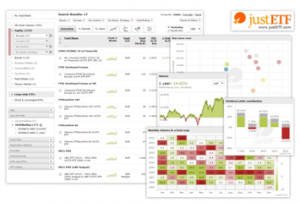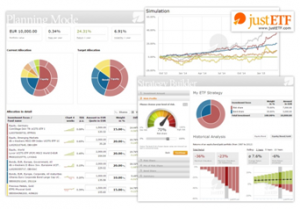Jan
2024
Investing Basics: ETF Portfolio Investing Made Simple
DIY Investor
27 January 2024
Dominique Riedl, founder and CEO of justETF, explains why he thinks ETFs are the right choice for DIY investors and explains how his platform can assist in selecting the right products to build and maintain a balanced investment portfolio.
Ever more people are taking charge of their financial futures – to invest for their later years, exploit the new pension freedoms, or simply to grow their wealth to keep up with rising house prices, school fees, and the like. With cash interest rarely, or barely, beating inflation that means investing in shares and bonds.
Where to start? Trust in financial services has never been lower, with many treating professional advisers with suspicion. Yet taking a DIY approach can be a daunting prospect.
Happily, there is a straightforward yet powerful strategy that squares this circle – passive investing with Exchange Traded Funds (ETFs).
Active Managers Don’t Beat the Market
ETFs make investing simple, cheap, and effective, even compared to more expensive and seemingly more sophisticated options. It might feel counterintuitive, but there’s a case against using professional active fund managers to invest in the markets. Indeed, several decades of academic research has shown the majority of fund managers do not beat their benchmarks.
As a group, active managers failed to protect investors in the 2008 stock market crash, and they’ve failed to match the subsequent recovery.
Seeking market-beating outperformance was always futile, because active managers are the market. If 50% of actively invested money beats the market in one year, then 50% must lose to make that possible.
Active investing can therefore be a zero sum game, and all the hype about clever managers providing an edge could be just that.
The other issue is their high fees. At most 10-20% of managers might beat the market long-term, yet 100% charge higher fees. In that respect it is pointless paying for a market-beating performance only to get a worse than average result.
An all-ETF Portfolio – the Best Solution for Most Investors
This is where ETFs come in; because it’s so hard to beat the market, it makes more sense not to try. Instead, invest as cheaply as possible using index-tracking funds that aim to secure the market return.
‘because it’s so hard to beat the market, it makes more sense not to try. Instead, invest as cheaply as possible using index-tracking funds that aim to secure the market return’
As well as shares, ETFs provide market-replicating access to bonds, commodities, real estate and money market funds. This means you can combine different ETFs to create a multi-asset portfolio that mirrors a sophisticated wealth management approach at a fraction of the cost.
Trading and running costs are low, so your ETF portfolio has the strong probability of outperforming expensive and sophisticated offerings that aim to do more, cost more, and ultimately fail their investors.
The ETF Advantage
US author Rick Ferri has published a white paper comparing an all-index tracking portfolio with one comprised of active mutual funds. He found the index fund portfolio beat the active one 90% of the time, and that this probability rose as time went on.
Despite this many investors still use several specialist active managers to invest in each asset category. Such diversity simply increases the chances of lagging the market.
Another approach is to outsource decision-making to a multi-asset manager. But again their mix of funds is likely to at best replicate the market, only now there are two layers of fees to pay.
justETF is an online tool that supports the (superior) ETF approach. It makes it easy for you to create and test your own ETF portfolios that you can then replicate in your own brokerage account. Portfolios can be built from scratch or you can get assistance from its strategy planner. It now costs only a few tenths of a percentage point to build a multi-asset portfolio that incorporates thousands of shares and other assets globally. All it takes are a handful of ETFs and a broker account to keep costs low.
Finding the Right ETF
There are around 800 ETFs listed on the London Stock Exchange. Competition has helped drive down costs, but also made it necessary to compare products.
Fig 1 justETF ETF Selector
justETF’s screening tool provides filters to help you comb through your personal ETF universe. As well as general data like fund size, it contains ETF specific information such as the replication method employed. It features line charts so you can compare the returns of different ETFs, and gives access to fee and risk comparisons.
Well-Grounded Model Portfolios
To get you started, justETF features model portfolio strategies for equity, bonds and commodities that can form the basis of your global multi-asset ETF portfolio. Experienced users can tweak these models by adjusting weightings or adding or removing ETFs to suit.
Portfolios have their own risk and return profile, which you should understand before investing. justETF offers historic return simulation in its portfolio planning tool. Past returns do not necessarily provide an insight about future returns, but at least you can understand how those returns were achieved.
Automatic Order Generation
Once you have decided on a portfolio, it is tedious to calculate all the necessary transactions required to buy it. The same is true of later portfolio adjustments, when selling is also required. justETF does these calculations for you. You can even specify your broker’s fee to correctly reflect the costs.
justETF is compatible with any broker. It replicates your real portfolio or enables you to run a ‘paper’ version of any ETF strategy you’d like to track.
Continuous Monitoring and Rebalancing
Recent volatility has shown portfolio monitoring is vital. Our platform always up-to-date reports on returns, risk, and portfolio allocation. It also features detailed attribution analysis.
You can even steer your portfolio by setting investment limits at the asset class level, as well as individual thresholds.
Fig 2 justETF Portfolio Planning Tool
There’s a major change in the markets? You will be informed via email, and can then rebalance your portfolio with just a few clicks. You can do the same thing for cash that’s added, too.
Many passive investors rebalance their portfolio allocations at the start of each year. But what if the market goes haywire in-between?
‘recent volatility has shown that constant monitoring is need’
The alternative is a bandwidth approach, where you take action if your asset allocation veers off-course, and perhaps even profit from such volatility. Bandwidths are automatically set to +/- 5% fluctuations around your strategic allocation, so they are unlikely be triggered more than two or three times a year. The limits can be adjusted as you see fit.
Professional and Independent Guidance
With its powerful tools and deep knowledge base, justETF offers professional and independent assistance with your investing, regardless of whether you follow a passive or active ETF strategy.
It is more than a tool. It enables you to implement a fully-fledged personal investment strategy that tilts the odds in your favour, with lower fees and far fewer hours than you’d spend researching and implementing an active fund approach.
For more information visit www.justetf.com
Commentary » Exchange traded products Commentary » Exchange traded products Latest » Financial Education » Latest » Uncategorized


Leave a Reply
You must be logged in to post a comment.